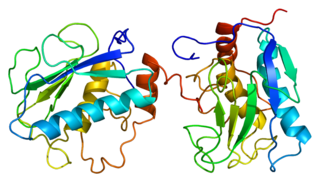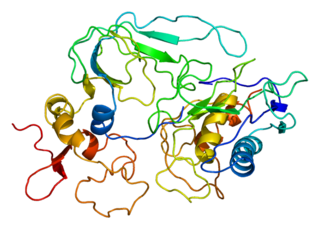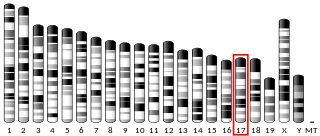Related Research Articles
Matrix metalloproteinases (MMPs), also known as matrix metallopeptidases or matrixins, are metalloproteinases that are calcium-dependent zinc-containing endopeptidases; other family members are adamalysins, serralysins, and astacins. The MMPs belong to a larger family of proteases known as the metzincin superfamily.
Gelatinases are enzymes capable of degrading gelatin through hydrolysis, playing a big role in degradation of the extracellular matrix and remodeling of tissue. Gelatinase is a type of Matrix Metalloproteinase (MMP), a family of enzymes that depend on zinc as a cofactor and can break down parts of the extracellular matrix. MMPs have multiple subgroups, including Gelatinase A (MMP-2) and Gelatinase B (MMP-9). Gelatinases are composed of a variety of EC numbers: Gelatinase A uses 3.4.24.24, and Gelatinase B uses 3.4.24.35, noting the ending overlap. The first digit, 3, is the class. Class 3 is hydrolases, or enzymes that catalyze hydrolysis reactions, or cleavage bonds with water. Next digit is sub-class 4, or proteases, which are enzymes who hydrolyze peptide bonds in proteins. The next number is the sub-subclass of 24, which classifies metalloendopeptidase- characterized by the existence of metal ions in the active site, in this case zinc, aiding the cleavage of peptide bonds. The last part of the EC number is the serial number, identifying specific enzymes within a sub-subclass. The 24 for Gelatinase A is a metalloproteinase that breaks down gelatin and collagen, while the 35 for Gelatinase B is for hydrolyzing peptide bonds.

Matrix metallopeptidase 9 (MMP-9), also known as 92 kDa type IV collagenase, 92 kDa gelatinase or gelatinase B (GELB), is a matrixin, a class of enzymes that belong to the zinc-metalloproteinases family involved in the degradation of the extracellular matrix. In humans the MMP9 gene encodes for a signal peptide, a propeptide, a catalytic domain with inserted three repeats of fibronectin type II domain followed by a C-terminal hemopexin-like domain.

72 kDa type IV collagenase also known as matrix metalloproteinase-2 (MMP-2) and gelatinase A is an enzyme that in humans is encoded by the MMP2 gene. The MMP2 gene is located on chromosome 16 at position 12.2.

Matrix metalloproteinase-14 is an enzyme that in humans is encoded by the MMP14 gene.
Interstitial collagenase, also known as fibroblast collagenase, and matrix metalloproteinase-1(MMP-1) is an enzyme that in humans is encoded by the MMP1 gene. The gene is part of a cluster of MMP genes which localize to chromosome 11q22.3. MMP-1 was the first vertebrate collagenase both purified to homogeneity as a protein, and cloned as a cDNA. MMP-1 has an estimated molecular mass of 54 kDa.

Stromelysin-1 also known as matrix metalloproteinase-3 (MMP-3) is an enzyme that in humans is encoded by the MMP3 gene. The MMP3 gene is part of a cluster of MMP genes which localize to chromosome 11q22.3. MMP-3 has an estimated molecular weight of 54 kDa.

Tissue inhibitor of metalloproteinases 2 (TIMP2) is a gene and a corresponding protein. The gene is a member of the TIMP gene family. The protein is thought to be a metastasis suppressor.

Matrilysin also known as matrix metalloproteinase-7 (MMP-7), pump-1 protease (PUMP-1), or uterine metalloproteinase is an enzyme in humans that is encoded by the MMP7 gene. The enzyme has also been known as matrin, putative metalloproteinase-1, matrix metalloproteinase pump 1, PUMP-1 proteinase, PUMP, metalloproteinase pump-1, putative metalloproteinase, MMP). Human MMP-7 has a molecular weight around 30 kDa.

Matrix metalloproteinase-26 also known as matrilysin-2 and endometase is an enzyme that in humans is encoded by the MMP26 gene.

Stromelysin-3 (SL-3) also known as matrix metalloproteinase-11 (MMP-11) is an enzyme that in humans is encoded by the MMP11 gene.

Matrix metalloproteinase-17 (MMP-17) also known as membrane-type matrix metalloproteinase 4 is an enzyme that in humans is encoded by the MMP17 gene.

Matrix metalloproteinase-25 is an enzyme that in humans is encoded by the MMP25 gene.

Matrix metalloproteinase 28 also known as epilysin is an enzyme that in humans is encoded by the MMP28 gene.

Matrix metalloproteinase-24 is an enzyme that in humans is encoded by the MMP24 gene.

Matrix metalloproteinase-20 (MMP-20) also known as enamel metalloproteinase or enamelysin is an enzyme that in humans is encoded by the MMP20 gene.
Metalloprotease inhibitors are cellular inhibitors of the Matrix metalloproteinases (MMPs). MMPs belong to a family of zinc-dependent neutral endopeptidases. These enzymes have the ability to break down connective tissue. The expression of MMPs is increased in various pathological conditions like inflammatory conditions, metabolic bone disease, to cancer invasion, metastasis and angiogenesis. Examples of diseases are periodontitis, hepatitis, glomerulonephritis, atherosclerosis, emphysema, asthma, autoimmune disorders of skin and dermal photoaging, rheumatoid arthritis, osteoarthritis, multiple sclerosis, Alzheimer's disease, chronic ulcerations, uterine involution, corneal epithelial defects, bone resorption and tumor progression and metastasis. Due to the role of MMPs in pathological conditions, inhibitors of MMPs may have therapeutic potential. Several other proteins have similar inhibitory effects, however none as effective. They might have other biological activities which have yet been fully characterised.

Matrix metallopeptidase 27 also known as MMP-27 is an enzyme which in humans is encoded by the MMP27 gene.
Pancreatic stellate cells (PaSCs) are classified as myofibroblast-like cells that are located in exocrine regions of the pancreas. PaSCs are mediated by paracrine and autocrine stimuli and share similarities with the hepatic stellate cell. Pancreatic stellate cell activation and expression of matrix molecules constitute the complex process that induces pancreatic fibrosis. Synthesis, deposition, maturation and remodelling of the fibrous connective tissue can be protective, however when persistent it impedes regular pancreatic function.
Angiogenesis is the process of forming new blood vessels from existing blood vessels, formed in vasculogenesis. It is a highly complex process involving extensive interplay between cells, soluble factors, and the extracellular matrix (ECM). Angiogenesis is critical during normal physiological development, but it also occurs in adults during inflammation, wound healing, ischemia, and in pathological conditions such as rheumatoid arthritis, hemangioma, and tumor growth. Proteolysis has been indicated as one of the first and most sustained activities involved in the formation of new blood vessels. Numerous proteases including matrix metalloproteinases (MMPs), a disintegrin and metalloproteinase domain (ADAM), a disintegrin and metalloproteinase domain with throbospondin motifs (ADAMTS), and cysteine and serine proteases are involved in angiogenesis. This article focuses on the important and diverse roles that these proteases play in the regulation of angiogenesis.
References
- Notes
- ↑ Cao, J. & Zucker, S. (n.d.). Introduction to the MMP and TIMP families (structures, substrates) and an overview of diseases where MMPs have been incriminated. Biology and chemistry of matrix metalloproteinases (MMPs). Retrieved from http://www.abcam.com/index.html?pageconfig=resource&rid=11034
- ↑ Murphy, G., Murphy, G., & Reynolds, J. (1991). The origin of matrix metalloproteinases and their familial relationships. Federation of European Biochemical Societies, 289 (1), 4-7. doi : 10.1016/0014-5793(91)80895-A
- ↑ Flinn, B. (2008). Review: Plant extracellular matrix metalloproteinases. Functional Plant Biology, 35, 1183-1193.
- ↑ McGeehan, G., Burkhart, W., Anderegg, R., Becherer, J. D., Gillikin, J. W., & Graham, J. S. (1992). Sequencing and Characterization of the Soybean Leaf Metalloproteinase. Plant Physiol., 99, 1179-1183.
- ↑ Carrilho, D., Duarte, I., Francisco, R., Ricardo, C., & Duque-Magalhaes, M. (2009). Discovery of Novel Plant Peptides as Strong Inhibitors of Metalloproteinases. Protein and Peptide Letters, 16, 543-551.
- ↑ Combier, J., Vernie, T., Billy, F., Yahyaoui, F., Mathis, R., & Gamas, P. (2007). The MtMMPL1 Early Nodulin is a novel member of the matrix metalloproteinase family with a role in Medicago truncatula infection by Sinorhizobium meliloti. Plan Physiology, 144, 703-716.
- ↑ Golldack, D., Popova, O., & Dietz, K. (2002). Mutation of the Matrix Metalloproteinase At2-MMP Inhibits Growth and Causes Late Flowering and Early Senescence in Arabidopsis. The Journal of Biological Chemistry, 277 (7) 5541-5547.
- ↑ . Graham, J. S., Xiong, J., & Gillikin, J. W. (1991). Purification and Developmental Analysis of a Metalloendoproteinase from the Leaves of Glycine max. Plant Physiol., 97, 786-792
- Bibliography
- Cao, J. & Zucker, S. (n.d.). Introduction to the MMP and TIMP families (structures, substrates) and an overview of diseases where MMPs have been incriminated. Biology and chemistry of matrix metalloproteinases (MMPs). Retrieved from http://www.abcam.com/index.html?pageconfig=resource&rid=11034
- Murphy, G., Murphy, G., & Reynolds, J. (1991). The origin of matrix metalloproteinases and their familial relationships. Federation of European Biochemical Societies, 289 (1), 4-7. doi : 10.1016/0014-5793(91)80895-A
- Flinn, B. (2008). Review: Plant extracellular matrix metalloproteinases. Functional Plant Biology, 35, 1183-1193.
- McGeehan, G., Burkhart, W., Anderegg, R., Becherer, J. D., Gillikin, J. W., & Graham, J. S. (1992). Sequencing and Characterization of the Soybean Leaf Metalloproteinase. Plant Physiol., 99, 1179-1183.
- Carrilho, D., Duarte, I., Francisco, R., Ricardo, C., & Duque-Magalhaes, M. (2009). Discovery of Novel Plant Peptides as Strong Inhibitors of Metalloproteinases. Protein and Peptide Letters, 16, 543-551.
- Combier, J., Vernie, T., Billy, F., Yahyaoui, F., Mathis, R., & Gamas, P. (2007). The MtMMPL1 Early Nodulin is a novel member of the matrix metalloproteinase family with a role in Medicago truncatula infection by Sinorhizobium meliloti. Plan Physiology, 144, 703-716.
- Golldack, D., Popova, O., & Dietz, K. (2002). Mutation of the Matrix Metalloproteinase At2-MMP Inhibits Growth and Causes Late Flowering and Early Senescence in Arabidopsis. The Journal of Biological Chemistry, 277 (7) 5541-5547.
- Graham, J. S., Xiong, J., & Gillikin, J. W. (1991). Purification and developmental Analysis of a Metalloendoproteinase from the Leaves of Glycine max. Plant Physiol., 97, 786-792.
- Ao, C., Li, A., Elzaawely, A., & Tawata, S. (2008). MMP-13 Inhibitory Activity of Thirteen Selected Plant Species from Okinawa. International Journal of Pharmacology, 4 (3), 202-207.